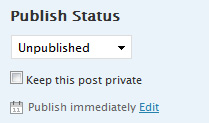If you want to start a blog, you should at least know some of the lingo used by bloggers and their blogs alike. A better understanding of just how WordPress works will ultimately make you a better webmaster.
1. Trackback
Trackbacks are used to notify authors of other blogs that you’ve referenced them or wrote something similar in an article you authored. You don’t necessarily have to link to an article to send a trackback. You can find the option to send a trackback at the bottom of each new post. Just copy and paste the link to another article and you’ll send a trackback. Trackbacks are often overlooked as it is just easier to send a pingback than a trackback.
2. Pingback
Pingbacks occur when you link to an article on another blog. The author will receive an email notification that you published a post that links back to one of their own previously published works. Pingbacks are commonly seen in the comments section of an article. They link back to the newly published article. Pingbacks differ from trackbacks because you have to actually link to the article within your post to notify the author.
3. Timestamps
Timestamps allow you to write a post and have it publish at the time and date of your choosing. Timestams are best described with an example. As I type this line and finish this article, it is currently Sunday night at 11:21PM. Yet, the post wasn’t published until 8AM Tuesday Morning. And no, I didn’t have to wake up at 8 just to hit the publish button. I set the timestamp to 8AM, pressed publish, and let WordPress take control.
Timestamps are usually overlooked by new bloggers. However, with the launch of WordPress 2.5, timestamps have been renamed and made more prominent.

Look familiar? Selecting edit will allow you to choose the time and date that your article will be published.
4. Widgets
Widgets are different sections you can add in your WordPress blog’s sidebar without ever having to edit HTML or CSS. Within widget ready themes, you can drag and drop different sections on your blogs sidebar to rearrange how and where your content is displayed.
5. Revisions
Revisions are relatively new to the WordPress scene. They allow authors to view previously saved versions of their work. It’s incredibly useful for a post that you have been developing for awhile and have made numerous edits to. Revisions let you quickly recover accidentally deleted content with just a click of a button. Frankly, revisions are long overdue and if you’re not on WordPress 2.6 yet, it’s time you upgrade.
6. Guest Posts
Guest posts are posts authored by individuals outside a blog’s typical authors. Guest posts benefit both parties. The blog that received the guest post is given free material and the author of the guest post receives exposure. Guest posts are a great way to build relationships with other bloggers in the same niche.
Can you think of any other terms new bloggers should learn?